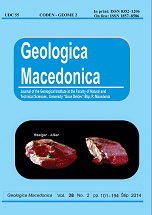Lithostratigraphic characteristics of paleogene basins in the Republic of Macedonia
Abstract
The Paleogene is one of the most intriguingintervals in the Earth history, marked by significantchanges in paleodynamic, palaeoclimate and inmarine productivity.Paleogene sediments are widespread in theRepublic of Macedonia and preserved with considerablythick masses on the Vardar zone, and insmaller relict masses on the Serbian-Macedonianmassif. During the Upper Cretaceous-Paleocene,after closure of the Vardar Ocean and collisionprocesses (Laramie orogeny phase), on the territoryof the Vardar zone and Serbian-Macedonianmassif, in conditions of extension, were formedcontinental trenches where Paleogene molassasediments are deposited. Early accumulation ofPaleogene sediments began with continental terrigenoussediments and, with gradual deepening ofthe environment, sedimentation was transformedinto marine sedimentation. After the formation ofthe Eocene-Oligocene sediment mass, during theUpper Miocene-Oligocene, it was subjected toPirinei-Sava compression, where Paleogene masswas dislocated, raised, faulted and exposed to intensiveerosion.Lithostratigraphical structure of Paleogene sedimentsin the basins can be analyzed on numerousopen cross sections. Deep drilling was performedin the Tikveš and Ovče Pole basin (to 2703 m).Paleogene sediments have been identified as UpperEocene – Priabonian and Lower Oligocene (Maksimovičet al., 1954; Dzuranov et al., 1999; Stojanova,2008) with a maximum thickness of 3000 –4000 m.Downloads
Download data is not yet available.
Downloads
Published
2014-12-29
Issue
Section
Articles
How to Cite
Lithostratigraphic characteristics of paleogene basins in the Republic of Macedonia. (2014). Geologica Macedonica, 28(2), pp. 175-183. https://js.ugd.edu.mk/index.php/GEOLMAC/article/view/924

